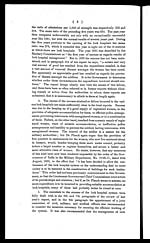Medicine - Institutions > Lock hospitals > Annual report on the working of the lock hospitals in the North-Western Provinces and Oudh > 1882
(311) [Page 1]
Download files
Individual page:
Thumbnail gallery: Grid view | List view
![(1) [Page 1] -](https://deriv.nls.uk/dcn17/7511/75111806.17.jpg)
IP/30/HG. 4
IP
No. 84 OF 1883.
FROM
THE SECRETARY TO GOVERNMENT,
N. -W. PROVINCES AND OUDH,
To
THE SECRETARY TO THE GOVERNMENT OF INDIA,
HOME DEPARTMENT (SANITARY).
Dated Naini Tal, the 4th August, 1883.
SIR,
I AM directed to forward, for the information of His Excellency
the Governor-General in Council, the annual report on the working of
the lock hospitals in the North-Western Provinces and Oudh for the
year 1882, together with the following remarks.
2. There were, as in 1881, 18 lock hospitals open during the
year, of which eight were of the first class, six of the second class, and
four of the third class. The results of their working during the year,
and the opinions expressed by the local authorities, are commented on in
detail in section I. of the report, and the results are also tabulated in the
four statements appended to it. The total expenditure on lock hospitals
during the year was slightly less than last year, having been Rs. 35,583 as
compared with Rs. 35,853. Towards this expenditure Government con-
tributed Rs. 8,988, and cantonment funds Rs. 26,595. The Jhánsi and
Cawnpore Cantonment funds, which last year received assistance from.
Government, bore the whole of the charges this year without such aid.
The fines realised amounted to Rs: 262. According to statement III.
the average cost per woman registered, per woman examined, and per
case of disease, was respectively Rs. 32-11-3, Rs. 37-11-8, and Rs. 12-4-0,
compared with Rs. 31-5-0, Rs. 36-8-8, and Rs. 11-4-6 in 1881. The
apparent increase in the cost of treatment is explained as due to the
diminution in the number of registered prostitutes. In Benares, where
the average number of women on the register is very much less than at
any other lock hospital of the first class, the average cost was very high,
and Dr. Planck proposes that Ránikhet, which has a much larger num-
ber of women on the register, should change places in the grading with
Benares. The proposal appears to be reasonable, and might be acted upon.
3. Statement No. IV., showing the prevalence of venereal diseases
amongst the soldiers of the European garrisons during 1882, brings
out somewhat unsatisfactory results. With a smaller number of troops
than last year, there is a decided increase in the number of admissions to
hospital for venereal diseases. The results attained varied considerably
at the different hospitals, and while the management of some was fairly
satisfactory, that of others was apparently productive of little or no good.
The daily average strength of the European garrison in these provinces
in 1881 and 1882 was 14,411 and 13,291 respectively, while the number
of admissions to hospital for venereal diseases was 3,340 and 3,506, and
Set display mode to: Large image | Zoom image | Transcription
Images and transcriptions on this page, including medium image downloads, may be used under the Creative Commons Attribution 4.0 International Licence unless otherwise stated. ![]()
| India Papers > Medicine - Institutions > Lock hospitals > Annual report on the working of the lock hospitals in the North-Western Provinces and Oudh > 1882 > (311) [Page 1] |
|---|
| Permanent URL | https://digital.nls.uk/75111804 |
|---|




